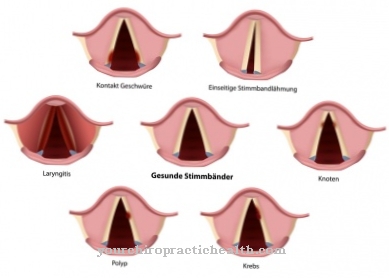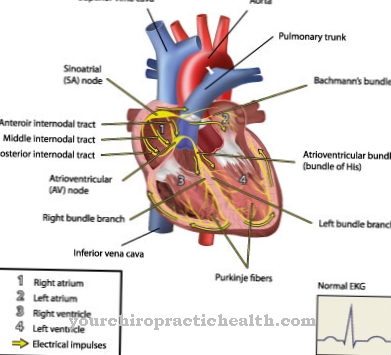The bags under the eyes are anatomical structures that everyone has and which usually become noticeable when the skin ages and the bags are perceived as an aesthetic impairment. In contrast, a Dacryocystitis also cause the bags under the eyes to be "unpleasant".
What is dacryocystitis?

© Andrea Danti - stock.adobe.com
The word dacryocystitis, which is used in definitions for the Lacrimal sack inflammation is used is made up of several parts.
The ending -itis is typical for the inflammation. In dacryocystitis, the inflammatory process is located directly in one or both bags under the eyes. The inflammation in dacryocystitis usually manifests itself in a very sensitive part of the eye region.
Dacryocystitis usually occurs in the area where the so-called inner corner of the eyelid meets the upper part of the nose. Dacryocystitis occurs in both very young children and adults.
causes
In the diseases of the tear ducts, to which dacryocystitis belongs, there are causes that are to be found in the infectious pathogens such as bacteria, viruses or in fine dirt particles.
In a microbiological smear, streptococci and pneumococci are predominantly found in dacryocystitis. Staphylococci are also among the pus-producing triggers of dacryocystitis. If dacryocystitis occurs in very young children, the tear ducts, which are usually not yet fully developed, are responsible.
In addition, some young children are born with a congenital obstruction of the tear duct, so that they can immediately develop dacryocystitis. Dacryocystitis can also occur when dirt is rubbed into the outlet of the lacrimal gland by unconsciously rubbing the eyes, which then becomes inflamed.
You can find your medication here
➔ Medicines for eye infectionsSymptoms, ailments & signs
In dacryocystitis, a pain-sensitive area develops between the lid and the eye. This swells in the course of the disease and leads to the typical swelling and reddening of the bags under the eyes. The affected area is warmer than other areas of the face and is also much more sensitive to pressure. As a result, the affected tear sac fills with pus.
Most of the time, pus also leaks from the affected eye, which can lead to inflammation and impaired vision. In addition, dacryocystitis leads to severe discomfort in the person affected. Usually there is an increasing feeling of illness, which has a long-term effect on physical and mental performance.
In addition, there are symptoms such as tiredness, fever and, under certain circumstances, cardiovascular problems. Outwardly, the disease can be recognized by the visible swelling of the tear sac. The flow of tears is usually increased, and the entire eye is usually red and swollen.
Dacryocystitis often affects both eyes. The swelling often goes away on its own and does not require any further clarification by the doctor. Sometimes, however, dacryocystitis can develop into a chronic condition with symptoms such as severe pain, redness, and impaired vision.
diagnosis
In dacryocystitis, at the beginning of the inflammation, an initially pain-sensitive area develops on the inside of the eye. In addition, this region, including the bags under the eyes, swells in dacryocysitis and becomes warmer than other facial areas.
Over time, dacryocystitis develops into an extremely painful impairment that encompasses the entire tear sac. Under certain circumstances, the patients with dacryocystitis suffer from a general physical malaise, similar to a flu-like infection.
Especially in small children, an increased body temperature and fatigue as well as the clearly visible swelling of the tear sac are recognizable. Often an increased leakage of secretion from the nose is noticeable in dacryocystitis. The tears also flow strongly. In dacryocystitis, pus can form at the exit of the tear duct. Usually both tear ducts are involved in dacryocystitis.
During the diagnosis, a microbiological culture can be set up in addition to the radiological representation of the tear systems.
Complications
Due to dacryocystitis, the patient usually suffers from discomfort in the eyes. These can be varied, so that different complications can also arise. Most of the time, however, the eyes are reddened and watery. There is no clear cause of the tearing, such as a foreign body in the eye.
This causes the eyes to swell and are also sensitive to pressure. It is not uncommon for severe pain in the eye region. The pain affects the patient in his everyday life. As a rule, a fever-like condition also occurs, with the patient feeling sick and tired. There is a general feeling of weakness.
With dacryocystitis, however, visual complaints can also occur if the person concerned no longer feels beautiful or has a reduced self-esteem. Treatment itself is carried out with the help of pain relievers and antibiotics. In most cases, these act relatively quickly and treat the disease well. Symptoms decrease over time. Surgical interventions are only necessary in rare cases.
When should you go to the doctor?
If the dacryocystitis persists for more than a few days, is unusually severe or causes symptoms, it is best to inform your family doctor or an ophthalmologist directly. It is possible that the bags under the eyes are caused by an allergy or disease that needs to be clarified and treated. In particular, persistent pain, redness or visual disturbances indicate a deeper problem - you should definitely see a doctor with these symptoms.
People who regularly suffer from bags under the eyes due to alcohol consumption, lack of sleep or excessive crying should discuss the underlying problems with a therapist. Comprehensive life counseling also helps occasionally. If the dacryocystitis is severe, the emergency medical service should be contacted.
This applies in particular to severe swelling and inflammation as well as bleeding in the area of the bags under the eyes. If the bags under the eyes lead to a reduced self-esteem, surgery is also an option. It is advisable to speak to your family doctor at an early stage, who can examine the dacryocystitis and, if necessary, initiate further measures.
Doctors & therapists in your area
Treatment & Therapy
The treatment of dacryocystitis depends on the age and extent of the person affected. Children are treated with massages of the bags under the eyes or with eye drops or eye ointments containing antibiotics.
There is also the option of injecting decongestant drugs directly into the eye or waiting for pus to drain. If this is not done with dacryocystitis, a surgical opening is performed. Dacryocystitis in adults is treated in such a way that ointments and drops are also administered, which are intended to combat both the symptoms and the causes.
If the diagnosis of dacryocystitis shows that the lacrimal duct that flows into the nose has closed, an opening is inevitable. This procedure is also known as dacryocystorhinostomosis (rhinos - the nose). In dacryocystitis, this technology is based either on an opening through the nose or outside.
Outlook & forecast
In most cases, dacryocystitis is an aesthetic complaint that therefore does not necessarily require treatment. If it does not lead to complaints or to restrictions in everyday life, no medical intervention is necessary.
Those affected can suffer from severe discomfort in the eyes with untreated dacryocystitis. This leads to watery and reddened eyes, which can also be swollen. In some cases, there is also eye pain. If the dacryocystitis is not treated, visual disturbances can also develop. Self-healing does not occur with this disease. Therefore, if it leads to symptoms, medical treatment is very useful.
The treatment itself can take place through surgery or with the help of medication. As a result, the symptoms of dacryocystitis are permanently resolved and there are no further complications or complaints. The life expectancy of the patient is also not reduced by the disease. In mild cases, the disease can also be treated with the help of massages or eye drops. This can also lead to a positive course of the disease.
You can find your medication here
➔ Medicines for eye infectionsprevention
To avoid dacryocystitis, cleanliness should be paramount. This is particularly the case with small children. In this regard, do not rub your eyes with dirty hands. If there is a noticeable increase in nasal secretions and pressure pain near the bags under the eyes, a doctor should be consulted in good time to prevent the dacryocystitis from progressing.
High-quality medicines help against dacryocystitis caused by permanently dry eyes, which keep the eyes moist and support the flushing out of foreign bodies. This also keeps the drainage channels for the tear fluid free and dacryocystitis can be prevented.
Aftercare
With dacryocystitis, follow-up measures are limited in most cases. The disease must first and foremost be treated by a doctor in order to alleviate the symptoms. Usually, there is no need for direct follow-up after the treatment itself if the dacryocystitis has been correctly corrected.
There are no particular complications and the life expectancy of the patient is not reduced by this disease. Dacryocystitis only needs to be treated if the person concerned feels uncomfortable with the symptoms or if they definitely want to correct them. A small surgical procedure takes place, whereby the patient should rest after the procedure and take care of his body.
The region of the eyes and head in particular should be particularly protected. To prevent infection or inflammation, the person with dacryocystitis should also take antibiotics after the procedure. It is important to ensure the correct dosage and regular intake. They should not be taken with alcohol.
You can do that yourself
The most effective remedy for dacryocystitis is prevention. Bags under the eyes can be avoided in many cases by keeping the eyes clean and moist. Particularly with small children, care should be taken that they do not rub their eyes with dirty hands.
Adults can reduce bags under the eyes by using face masks with cottage cheese or cucumber. Equally effective: a used tea bag with green or black tea, which is cooled and placed on the bags under the eyes. Alternatively, aloe vera, nut oil or wheat germ oil can be placed on the closed eyes.
Eyebright tea or chamomile cream from the pharmacy help reduce the swelling of the bags under the eyes. In addition, regular massages and sports such as jumping rope or jogging are recommended. Stepping or hopping on the indoor trampoline also reduces the accumulation of water in the tissue and improves the overall blood flow to the bags under the eyes and the entire body.
Those affected should also use dietary measures. Salt consumption is best reduced (the mineral binds fluids and thereby increases the risk of bags under the eyes), while alcohol and nicotine should be avoided completely. The tips mentioned are best used in consultation with the family doctor so that there are no complications in self-treatment of dacryocystitis.




.jpg)



















.jpg)



